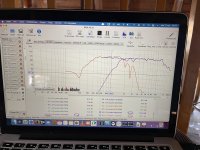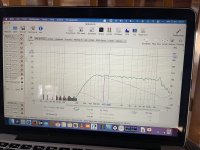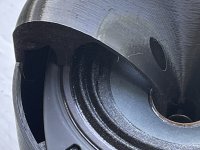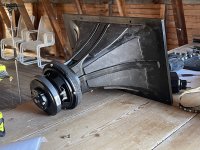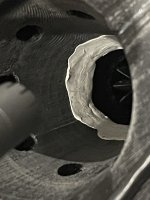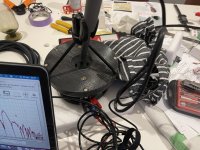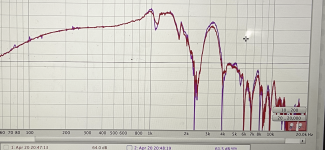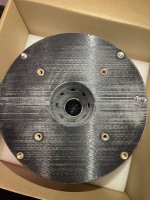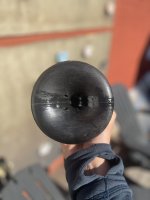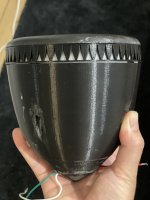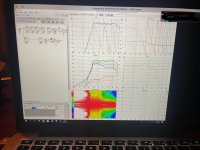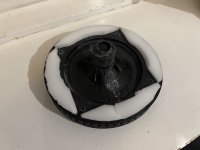For home use, the HF108 has more than enough output if crossed around 1kHz on a conical horn.For the current use, the HF108s would be great to below 1khz. However, on reflection it would be prudent to allow for future eventualities, needing more SPL - such as for Home Theater use, or bigger rooms than the current one. That could mean crossing higher (to smaller/more woofers), but I think there are still other reasons why crossing low remains desirable.
In that latter case, a compression driver with bigger diaphragm could make sense.
The purple trace in Mark100's Syn11 is the response of four B&C NDF34, nicely covering 180Hz to 1kHz.
On a conical horn, I'd prefer their sound in the 400-1kHz range over any compression driver.
Mark is crossing them ~700 Hz to the B&C DCX 464 coax compression driver.
Four NDF34 can do ~116dB at 160Hz at one meter within Xmax, they can be crossed to low frequency drivers mounted internally or externally.
I've listened to them outdoors on a horn with a mouth the size of the back chamber in the above photo playing above three EV MTL4 (quad 18") subs, they got louder than I'd care to listen to at under 8 meters or so.
Art
Thank you, Art. That is very good to hear. I had actually been wondering about crossing lower, since that would be possible with just a simple step up in compression driver size. But there is no pressing need to do so, and it would appear no point if cones are arguably preferable in that range. A 2way would still reach up to 1khz with the modest size of woofers I'd need, so there would be no extra requirement for additional midranges. I may as well just stick with the HF108s then; I have been very pleased with them.
Thanks again,
Kev
Thanks again,
Kev
Hi Kev,
It's nice when a CD can reach down to largish cone drivers which themselves can reach down to 100Hz (my sub xover target).
But it's a bit of a tightrope until CD xover point is down to at least 700Hz, ime. Not saying it can't be done at say 1000Hz, just saying everything will have to be spot on in terms of port placements vs driver size selection.
We all know the closer the cone ports are to the CD, the higher the cone will reach before 1/4 wave notch makes further upward response unusable..
I've also found though, that larger cones (8" and up), tend to peter out before even reaching the notch frequency, when their ports are neared the cones surrounds.
Move the ports towards the center of the cone, and that has pushed up freq response, but has also pushed down the notch frequency. So a real tug of war their, notch vs natural extension.
Also getting down to 100Hz has been aided by being further out the horn, so it end up being notch is the problem.
Easiest solution is to just go with a CD that gets low enough to avoid all the juggling.....
Or use small mids between the CD and low drivers. I really think this is the way to go btw. Let's us use whatever CD we want that gets to 1000Hz, use all kind of mids (i've had great success with both well regarded 4ndf34 as well as faital 4fe35's. And pretty low cost 10"s +/- inches.
If you do want to stick to 2-way though, every 100Hz below 1kHz it can get to at desired SPL, simply opens more cone options...
It's nice when a CD can reach down to largish cone drivers which themselves can reach down to 100Hz (my sub xover target).
But it's a bit of a tightrope until CD xover point is down to at least 700Hz, ime. Not saying it can't be done at say 1000Hz, just saying everything will have to be spot on in terms of port placements vs driver size selection.
We all know the closer the cone ports are to the CD, the higher the cone will reach before 1/4 wave notch makes further upward response unusable..
I've also found though, that larger cones (8" and up), tend to peter out before even reaching the notch frequency, when their ports are neared the cones surrounds.
Move the ports towards the center of the cone, and that has pushed up freq response, but has also pushed down the notch frequency. So a real tug of war their, notch vs natural extension.
Also getting down to 100Hz has been aided by being further out the horn, so it end up being notch is the problem.
Easiest solution is to just go with a CD that gets low enough to avoid all the juggling.....
Or use small mids between the CD and low drivers. I really think this is the way to go btw. Let's us use whatever CD we want that gets to 1000Hz, use all kind of mids (i've had great success with both well regarded 4ndf34 as well as faital 4fe35's. And pretty low cost 10"s +/- inches.
If you do want to stick to 2-way though, every 100Hz below 1kHz it can get to at desired SPL, simply opens more cone options...
Thank you, Mark. Those are some really useful insights into the balancing act and tradeoffs that must be made. I doubt my first serious attempt at a MEH will be anywhere near as optimum as experienced people would achieve, so it is probably best for me not to bank on stretching things too far.
Which might bring me back to either a lower crossover or a 3-way, for best chances of success. The former would be simple but would cost more (indicating a bigger compression driver), whilst the latter would be more flexible but also more complicated (another 'way' to integrate).
Of the two, it is interesting to hear that you prefer using small mids. I vaguely recall Art mentioning a preference for this too, on some thread or other, though I can't recall the exact context. I suppose it is more in the spirit of the MEH approach. I'll have to see how much bigger an additional few 3" or 4" drivers might require the base cabinet to be, before extensions.
Thanks again, people's thoughts here are really helping me to see the possibilities and compromises.
Kev
Which might bring me back to either a lower crossover or a 3-way, for best chances of success. The former would be simple but would cost more (indicating a bigger compression driver), whilst the latter would be more flexible but also more complicated (another 'way' to integrate).
Of the two, it is interesting to hear that you prefer using small mids. I vaguely recall Art mentioning a preference for this too, on some thread or other, though I can't recall the exact context. I suppose it is more in the spirit of the MEH approach. I'll have to see how much bigger an additional few 3" or 4" drivers might require the base cabinet to be, before extensions.
Thanks again, people's thoughts here are really helping me to see the possibilities and compromises.
Kev
Still no MS windows (for hornresp) as I'm waiting on a replacement SSD for the laptop. However I've had a look at how 2-way and 3-way versions might work with my requirement for a compact enclosure (before adding removable cone extensions and flare).
Aside from a couple of awkward shapes, adding four midranges almost always makes things noticeably bigger. However adding two midranges can be done with little or no increase in size, if they use two sides of the horn and the woofers use the other two. That is assuming that two midranges would achieve sufficient SPL anyway, which I believe they could for home listening purposes.
e.g:

A few sizes of midrange might work, but (looking at say 1khz tap positions on a 90degree cone) 4" or 5" true frame size might be most optimal. 4" is a little smaller for spanning two corner taps (though I could move them in a bit) whilst any bigger than 5" starts to move the driver further down the cone (even a 'nominal' 5" cone with larger frame size) .
In a 3-way there are obviously a second set of taps for the bass drivers; which will need to be some distance along the cone. This makes little difference for 8" woofers, but for 6" woofers it probably means moving them further down the cone to reach the tap; they therefore offer less space saving (over an 8") than they would in a 2-way configuration. Though this is at least slightly helpful in leaving more space for midranges to overlap the corners of the cone.
Overall then, a 3-way might not be 'quite' as compact as a 2-way could be, but it could still be acceptably sized. There are of course more "ways" to deal with but in mitigation it seems easier to cover the range in three ways instead of two ways; 8" MEH drivers certainly can reach a 1khz crossover in the right hands, but I have found threads with people struggling with even 6" - and I don't yet know how skilled (or unskilled) I will be in this respect.
So after lots of thread-reading and drawing.... no clear decision has emerged! Perhaps the biggest potential interest I've found in 3-ways are suggestions that dedicated small midranges on MEHs can sound better for home hifi - compared to either 2-ways and/or using a compression driver lower down in frequency. No doubt that will be partly down to implimentation (and personal taste; each method has its fans) but it leads me to feel that a 3-way "might" offer more chance of (me) achieving best fidelity; which is my aim in doing all this. Were it not for that I would likely attempt the 2-way for compactness.
Kev
Aside from a couple of awkward shapes, adding four midranges almost always makes things noticeably bigger. However adding two midranges can be done with little or no increase in size, if they use two sides of the horn and the woofers use the other two. That is assuming that two midranges would achieve sufficient SPL anyway, which I believe they could for home listening purposes.
e.g:
A few sizes of midrange might work, but (looking at say 1khz tap positions on a 90degree cone) 4" or 5" true frame size might be most optimal. 4" is a little smaller for spanning two corner taps (though I could move them in a bit) whilst any bigger than 5" starts to move the driver further down the cone (even a 'nominal' 5" cone with larger frame size) .
In a 3-way there are obviously a second set of taps for the bass drivers; which will need to be some distance along the cone. This makes little difference for 8" woofers, but for 6" woofers it probably means moving them further down the cone to reach the tap; they therefore offer less space saving (over an 8") than they would in a 2-way configuration. Though this is at least slightly helpful in leaving more space for midranges to overlap the corners of the cone.
Overall then, a 3-way might not be 'quite' as compact as a 2-way could be, but it could still be acceptably sized. There are of course more "ways" to deal with but in mitigation it seems easier to cover the range in three ways instead of two ways; 8" MEH drivers certainly can reach a 1khz crossover in the right hands, but I have found threads with people struggling with even 6" - and I don't yet know how skilled (or unskilled) I will be in this respect.
So after lots of thread-reading and drawing.... no clear decision has emerged! Perhaps the biggest potential interest I've found in 3-ways are suggestions that dedicated small midranges on MEHs can sound better for home hifi - compared to either 2-ways and/or using a compression driver lower down in frequency. No doubt that will be partly down to implimentation (and personal taste; each method has its fans) but it leads me to feel that a 3-way "might" offer more chance of (me) achieving best fidelity; which is my aim in doing all this. Were it not for that I would likely attempt the 2-way for compactness.
Kev
Last edited:
Although the above drawings are just crude examples to get a general idea. I'd imagine that using oddly shaped frustrums and playing about a bit more would mean even less difference in cabinet size between 2-way and 3-way designs (at least, if only 2xmidranges were needed per speaker). e.g:

So I very much have the choice of 2-way or 3-way on their own merits.
Its reaching the stage where things look physically feasible, so I very much need to get hornsrep working to see what the audio implications are of these various possibilities.
So I very much have the choice of 2-way or 3-way on their own merits.
Its reaching the stage where things look physically feasible, so I very much need to get hornsrep working to see what the audio implications are of these various possibilities.
One thing I have noticed with my 3way builds is that it is beneficial to use the bandpass effect on the bass drivers as low as possible - which means more volume for the front chamber - you want them to play only as high as necessary, sort of opposite to mid drivers. Two midranges are definitely enough for home volumes - especially if you use the 4" BC. Even two FaitalPro 3FE22s were plenty for me. And the small designs on the forum use just one midrange. Speaking about that, I tried a single midrange on top and a single bass driver on the bottom of the horn and it was fine as well. It would make a very compact basic box with the right drivers.
Thank you, pelanj. That probably highlights an advantage of having the big woofers dedicated to bass; freedom to improve the low end without complications of needing to also go very high. I only 'need' these to go down to 80hz as my preference is for distributed subwoofers below there, but it wouldn't be a bad thing for them to reach lower (e.g. for situations in which subs might not be available).
More front-chamber volume might also be helpful for getting the drivers into convenient positions - not directly over the taps. I've seen a thread somewhere with (quite a complicated) printed horn that uses a front chamber to place the taps out on the front corners of the horn, which aren't really beneath the driver. I wasn't intending to print this project, but vaguely similar things could probably be done in different ways.
That is good news on the 2x midrange SPL, too. I've got a few 4fe35 drivers which I've seen used on MEHs, and it sounds like a pair of them should suffice, if two of the smaller 3fe22s were already sufficient. though it seems like the B&C drivers might be even better. I've also got some 5FE120s somewhere, though no idea if they have suitable parameters for this, will have to check.
Thanks again,
Kev
More front-chamber volume might also be helpful for getting the drivers into convenient positions - not directly over the taps. I've seen a thread somewhere with (quite a complicated) printed horn that uses a front chamber to place the taps out on the front corners of the horn, which aren't really beneath the driver. I wasn't intending to print this project, but vaguely similar things could probably be done in different ways.
That is good news on the 2x midrange SPL, too. I've got a few 4fe35 drivers which I've seen used on MEHs, and it sounds like a pair of them should suffice, if two of the smaller 3fe22s were already sufficient. though it seems like the B&C drivers might be even better. I've also got some 5FE120s somewhere, though no idea if they have suitable parameters for this, will have to check.
Thanks again,
Kev
I can find long discussions (and even a formula) on criteria that make good midrange drivers (for MEHs), but not so much on bass drivers for 3-ways. Perhaps it matters less for these (they don't need pushing to high frequencies), and I've seen it suggested that most bass drivers should just work. However I'm suspicious, since others have had difficulty getting some bass drivers to work well.
I could just use what has worked for others, and Pelanj kindly recommended the Fane Sovereign 8-225 which I think may be available here. But for more design/buying choices, I'm curious to know if there are any desirable characteristics to look for in MEH bass drivers?
I could just use what has worked for others, and Pelanj kindly recommended the Fane Sovereign 8-225 which I think may be available here. But for more design/buying choices, I'm curious to know if there are any desirable characteristics to look for in MEH bass drivers?
When making the SH50s I was planning to use the Faital 12HP1020 that I understand the originals use.
I have used fairly cheap Eminence Kappa 12As (450w) in previous exponential horns and liked the sound and measurement.
The T&S Faital and Eminence were not that far apart, so I thought I'd give them a go.
I'm very pleased with the Kappas sound and measurements. I'm only using them for hifi so far and would add a 2nd driver per cab for more dB demanding use.
I have used fairly cheap Eminence Kappa 12As (450w) in previous exponential horns and liked the sound and measurement.
The T&S Faital and Eminence were not that far apart, so I thought I'd give them a go.
I'm very pleased with the Kappas sound and measurements. I'm only using them for hifi so far and would add a 2nd driver per cab for more dB demanding use.
I have also used Thomann the.box 12-280 (12"), Hadex 18" and multiples of Hadex 6.5" woofers. In the low frequencies, the horn does not do much. You can get a good approximation for the LF simulating a sealed back or vented back bandbass box with the available back volume, front chamber volume, and port area and lenght. Since you (and me as well) do not need extreme low extension, I would prefer sealed back, since it can be pretty safely boosted by a few dB at the low end. So if a woofer is suitable for 4th order bandpass box, it will work well as MEH bass. Or 6th order if you want to go vented. I always simulated with trial and error in Hornresp - since I still do not fully understand how to do this properly. The bandpass experts here would definitely help with this.
Thank you, everyone. Pelanj, thanks for the suggestion; I have played with bandpass designs in the past and so this should be reasonably easy to repeat here. It was in winisd and I just fiddled with the enclosure parameters to get the kind of width and flatness wanted for the frequency response; not massively scientific but it worked. I too would prefer sealed and should be able to add DSP/EQ where needed.
First I want to simulate the use of four or more smaller bass drivers; this should tell me about simple SPL vs frequency response, at least. In theory they may allow a smaller cabinet (than using a couple of big ones). Though in practice may not; if the design turns out to be excursion limited then a much larger total cone area may be needed - especially if considering distortion rather than simple Xmax of the smaller drivers.
Though I need to avoid becomming obsessed over a few inches less cabinet size. It is a questionable idea to begin with, since one or two big bass drivers (say 8-inch or 10-inch) would be cheaper, lighter and allow me to follow proven choices. However, I realised that on occasions where the cabinet could be placed in a corner, the horizontal cone extensions could be left off. Which would be nice but also more limiting on where in the cabinet big drivers can go.
First I want to simulate the use of four or more smaller bass drivers; this should tell me about simple SPL vs frequency response, at least. In theory they may allow a smaller cabinet (than using a couple of big ones). Though in practice may not; if the design turns out to be excursion limited then a much larger total cone area may be needed - especially if considering distortion rather than simple Xmax of the smaller drivers.
Though I need to avoid becomming obsessed over a few inches less cabinet size. It is a questionable idea to begin with, since one or two big bass drivers (say 8-inch or 10-inch) would be cheaper, lighter and allow me to follow proven choices. However, I realised that on occasions where the cabinet could be placed in a corner, the horizontal cone extensions could be left off. Which would be nice but also more limiting on where in the cabinet big drivers can go.
Well a bit more playing, and I'm reaching more ideas that appeal to me. At least in a physical sense; whether they are workable from an audio perspective remains to be tested in hornresp.
Pelanj mentioned the possibility of a larger front chamber for the bass woofers, helping low-end extension. Such a chamber could also allow the driver to be connected to the taps without being especially close to them (seems to be an advantage of having smaller separate midranges; they can be the ones with small chambers, needed to reach higher up). So, I could then use large drivers pushed to the back of the cabinet, without having to make the cabinet deeper for them. That appeals as 2x bigger bass woofers per speaker can be cheaper and lighter than using 4x smaller ones.

In fact, the extra thickness of a chamber might also allow the bass drivers to clear the compression driver, allowing them to go even further back (and therefore keeping the cabinet even shorter.

It does make a taller cabinet, but IMO a small footprint is more useful; height isn't so much of an issue for left and right speakers (I'm not envisioning needing a centre speaker). I also think it seems more normal for home hifi speakers to be taller than they are wide.
At least the extra height between woofers means extra space for midranges on the sides. Up to two 3" drivers would easily fit on each of the sides, whereas previously much over one 4" was starting to get fiddly.

3" ones might be more appealing for fitting the speakers into corners (if/when the room is conducive). The cabinet can't fit snugly because of the compression driver, but it looks like 3" mid ranges could use that existing gap whilst larger ones would make the gap bigger:

So that kind of layout ticks all my wish-list boxes, or at least gets as close as I'm reasonably likely to. So it'll now be a case of simulating specific drivers and finding out what alterations are needed to make the idea actually work, or if indeed it can at all. My laptop SSD has arrived so hopefully that will mend it, and allow me to set up windows software such as hornresp and winisd etc
Pelanj mentioned the possibility of a larger front chamber for the bass woofers, helping low-end extension. Such a chamber could also allow the driver to be connected to the taps without being especially close to them (seems to be an advantage of having smaller separate midranges; they can be the ones with small chambers, needed to reach higher up). So, I could then use large drivers pushed to the back of the cabinet, without having to make the cabinet deeper for them. That appeals as 2x bigger bass woofers per speaker can be cheaper and lighter than using 4x smaller ones.
In fact, the extra thickness of a chamber might also allow the bass drivers to clear the compression driver, allowing them to go even further back (and therefore keeping the cabinet even shorter.
It does make a taller cabinet, but IMO a small footprint is more useful; height isn't so much of an issue for left and right speakers (I'm not envisioning needing a centre speaker). I also think it seems more normal for home hifi speakers to be taller than they are wide.
At least the extra height between woofers means extra space for midranges on the sides. Up to two 3" drivers would easily fit on each of the sides, whereas previously much over one 4" was starting to get fiddly.
3" ones might be more appealing for fitting the speakers into corners (if/when the room is conducive). The cabinet can't fit snugly because of the compression driver, but it looks like 3" mid ranges could use that existing gap whilst larger ones would make the gap bigger:
So that kind of layout ticks all my wish-list boxes, or at least gets as close as I'm reasonably likely to. So it'll now be a case of simulating specific drivers and finding out what alterations are needed to make the idea actually work, or if indeed it can at all. My laptop SSD has arrived so hopefully that will mend it, and allow me to set up windows software such as hornresp and winisd etc
Last edited:
I found that thread I mentioned earlier, with the front chamber being used to put taps/ports further out into the corners of the horn (than the driver itself reaches). It was bwaslo's rather advanced and inspiring printed waveguide thread. Zaxder later made an impressive version in a lighter coloured material that is a little easier to make out in the photos, if I might refer to them for illustration:


It differs a little from my intent, because this/bwaslo's waveguide is the full size (not expecting extensions), but the front chamber and tap arrangement are very interesting.
Though the chamber is smaller than I was envisioning, and no doubt the simulations will show why. Though hopefully that won't matter. As I see it, provided the outer edge of the front chamber and taps remain where they should be (i.e. without needing a long port or tunnel), it possibly doesn't matter where the rest of the driver and chamber is. So they could be angled relative to the cone, to leave more space for midrange and compression driver clearance.
e.g:

or even:

(that latter seems extreme unless you wanted to fit 4x big bass drivers, which I don't. But by exaggeration it illustrates the principle I'm thinking of).
It differs a little from my intent, because this/bwaslo's waveguide is the full size (not expecting extensions), but the front chamber and tap arrangement are very interesting.
Though the chamber is smaller than I was envisioning, and no doubt the simulations will show why. Though hopefully that won't matter. As I see it, provided the outer edge of the front chamber and taps remain where they should be (i.e. without needing a long port or tunnel), it possibly doesn't matter where the rest of the driver and chamber is. So they could be angled relative to the cone, to leave more space for midrange and compression driver clearance.
e.g:
or even:
(that latter seems extreme unless you wanted to fit 4x big bass drivers, which I don't. But by exaggeration it illustrates the principle I'm thinking of).
Last edited:
Very interesting.
Quite something that printed one.
Perhaps you covered it earlier and I missed it - you have taps for the MF and LF as usual, nicely 1/4 wavelength.
Will you have ports for the bass reflex effect too?
Quite something that printed one.
Perhaps you covered it earlier and I missed it - you have taps for the MF and LF as usual, nicely 1/4 wavelength.
Will you have ports for the bass reflex effect too?
Yes, I agree. I'm getting quite enthusiastic about this now (often dangerous!). It is still very much an early paper exercise in my case, so may go nowhere. But with examples like that, it looks promising enough for me to pursue further, which will involve a lot of learning.
I'm hoping for a sealed 4th-order enclosure for the bass drivers; it should suffice, as I'll be happy to use DSP and/or to cross over to subwoofers. If I did want an extra reflex port... I'm not sure what I'd do with it; it might require the cone to be longer/bigger, or to be pointed out the back, which aren't really very appealing options. TBH I'm just hoping not to go there.
I'm hoping for a sealed 4th-order enclosure for the bass drivers; it should suffice, as I'll be happy to use DSP and/or to cross over to subwoofers. If I did want an extra reflex port... I'm not sure what I'd do with it; it might require the cone to be longer/bigger, or to be pointed out the back, which aren't really very appealing options. TBH I'm just hoping not to go there.
Not going in to details here but I’ve been doing some experiment with pro coax in the style of Danley patent fig 7 and renkuz-Heinz coentrant driver and it’s a really nice way to get the midrange taps close to the tweeter and potentially make it as compact as possible.


The latest experiment with 6” redcatt coax on a 2” horn shows potential.
The latest experiment with 6” redcatt coax on a 2” horn shows potential.
Attachments
Last edited:
Raw nearfield of only the coentrant driver.
The red is with some melamine foam pushed down to where the phase plug ends.
And the dip at 1100Hz is leakage from where the printed part meets the aluminum conical part of the driver. A quick test with blutack confirmed it.
The red is with some melamine foam pushed down to where the phase plug ends.
And the dip at 1100Hz is leakage from where the printed part meets the aluminum conical part of the driver. A quick test with blutack confirmed it.
Attachments
And so sorry for my rant here, but my little 4” with passive cardioid can control directivity down to 500Hz. But will probably be limited in max spl.
A MEH doesn't have to be big..
It started here:
https://www.diyaudio.com/community/...he-easy-way-ath4.338806/page-671#post-7417700
And along the way I investigated passive cardioid https://www.diyaudio.com/community/...he-easy-way-ath4.338806/page-676#post-7425742
But the attached is the latest bigger leakage and melamine foam version.
A MEH doesn't have to be big..
It started here:
https://www.diyaudio.com/community/...he-easy-way-ath4.338806/page-671#post-7417700
And along the way I investigated passive cardioid https://www.diyaudio.com/community/...he-easy-way-ath4.338806/page-676#post-7425742
But the attached is the latest bigger leakage and melamine foam version.
Attachments
- Home
- Loudspeakers
- Multi-Way
- Multiple Entry Horn with removable mouth?
